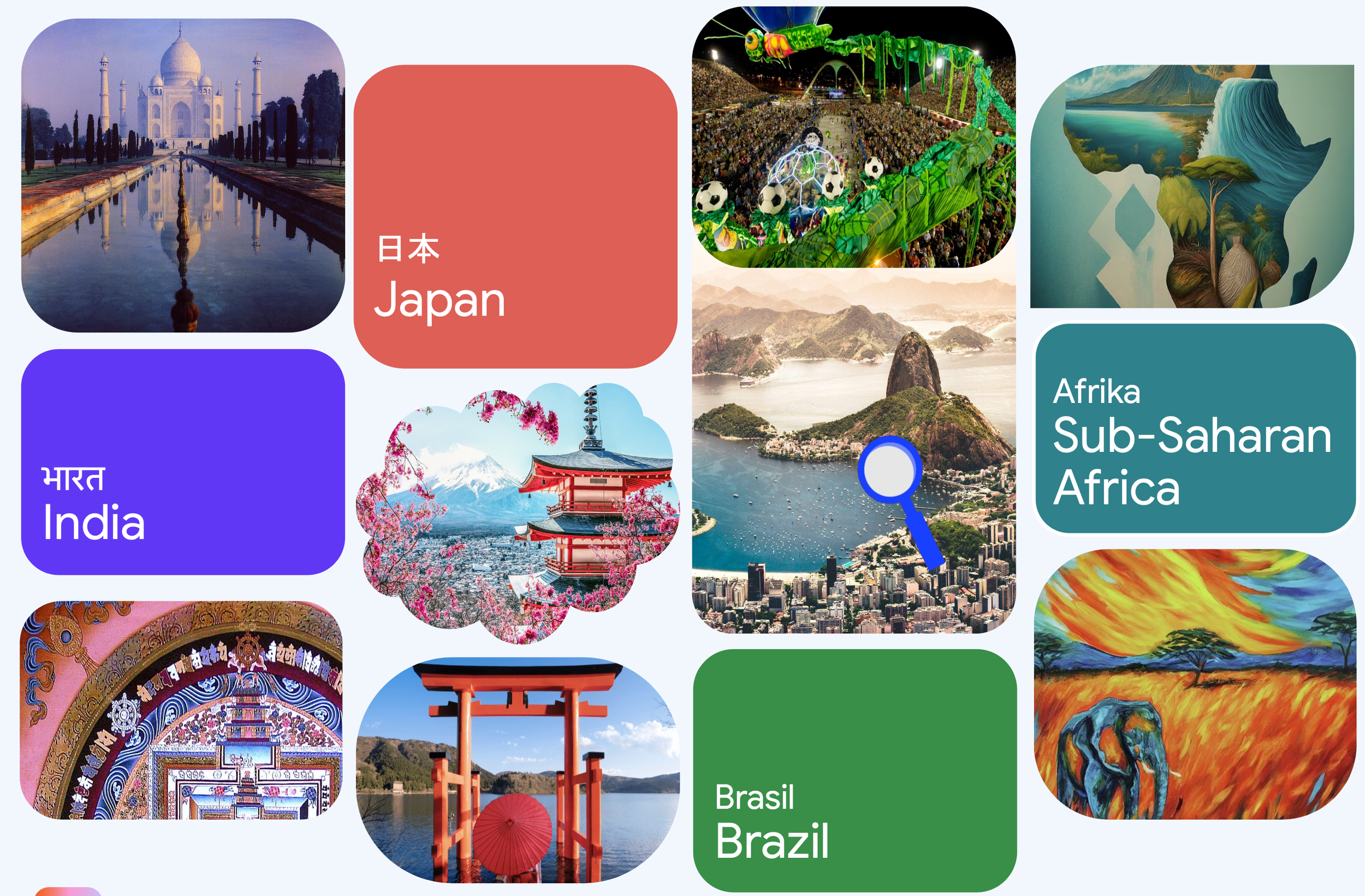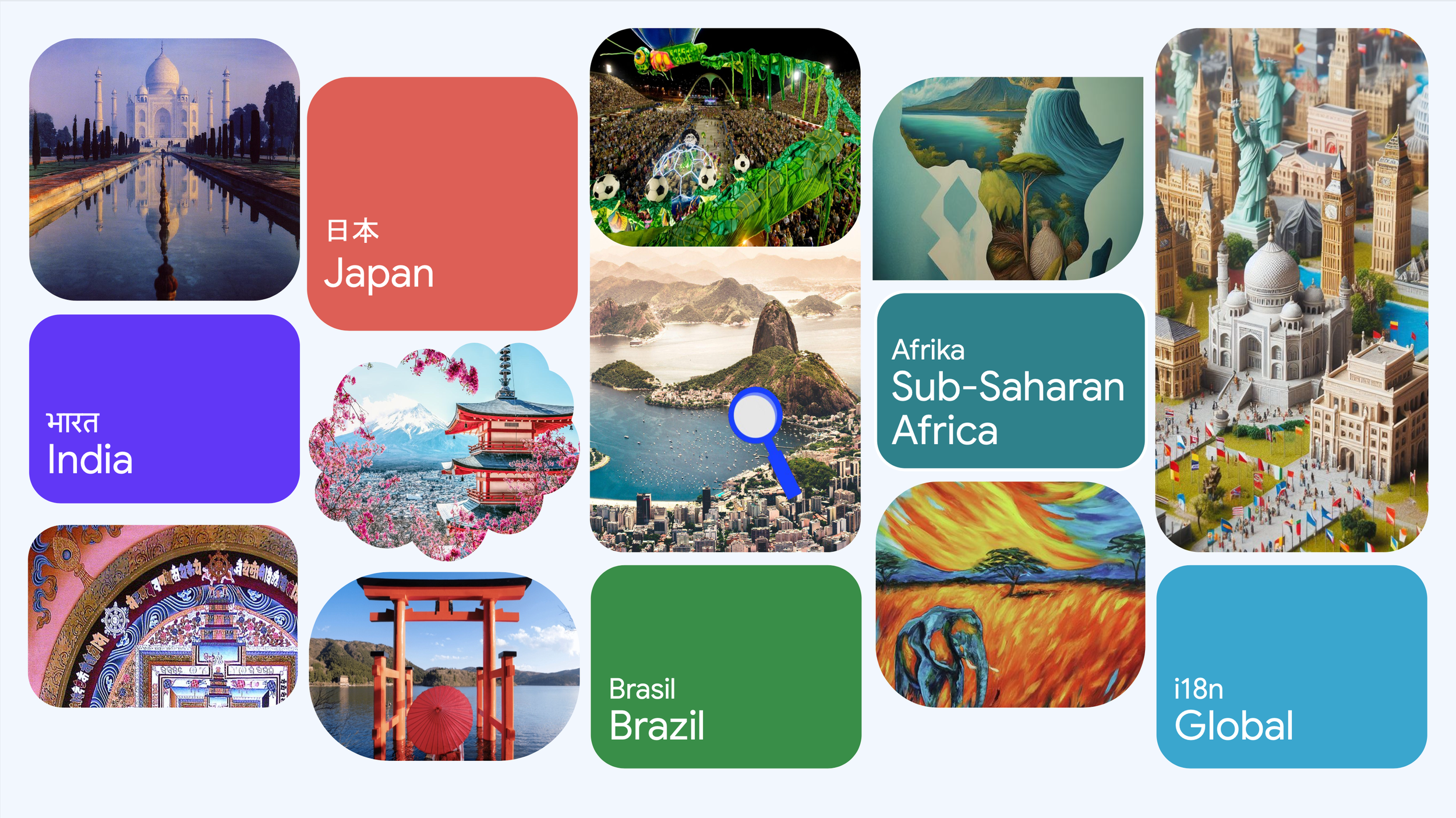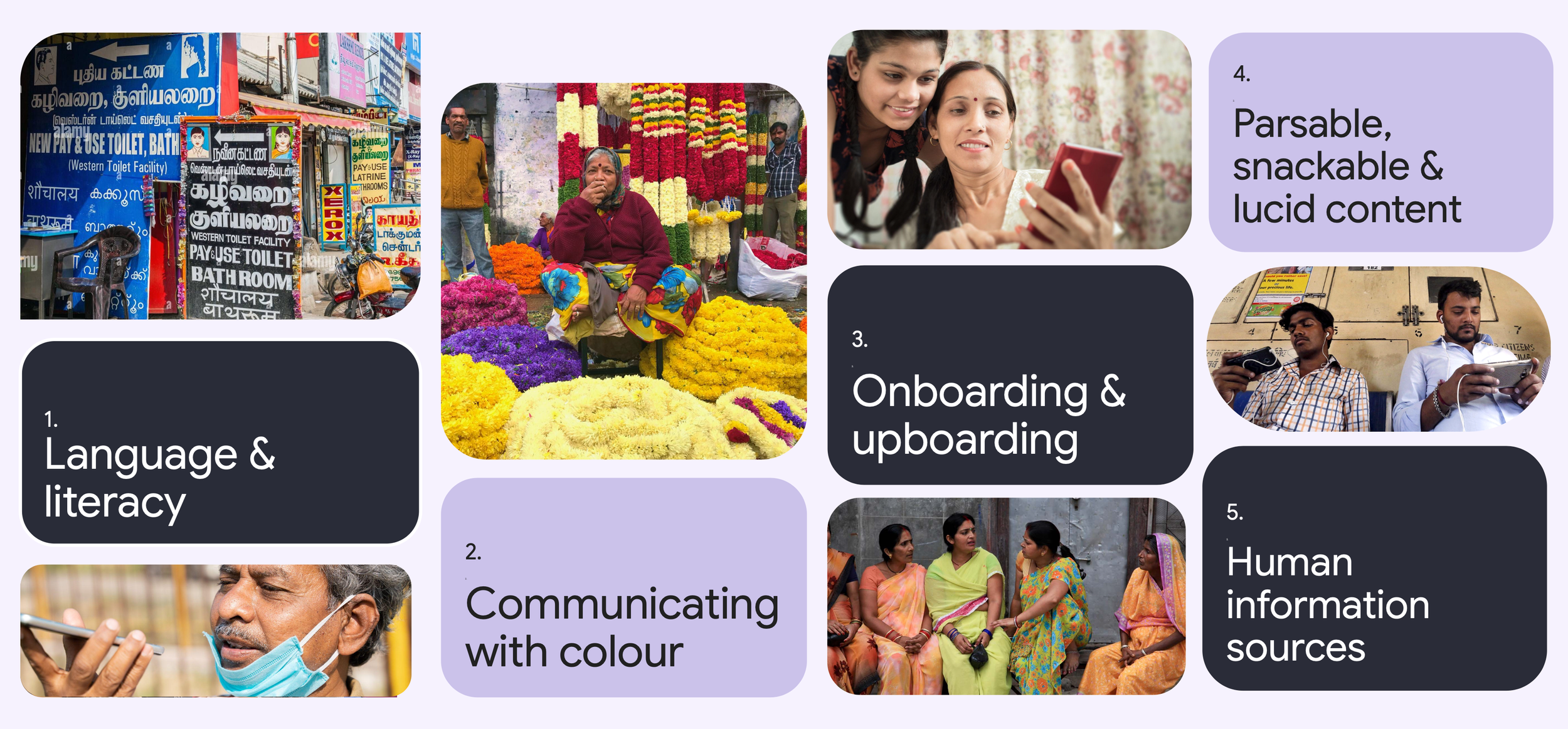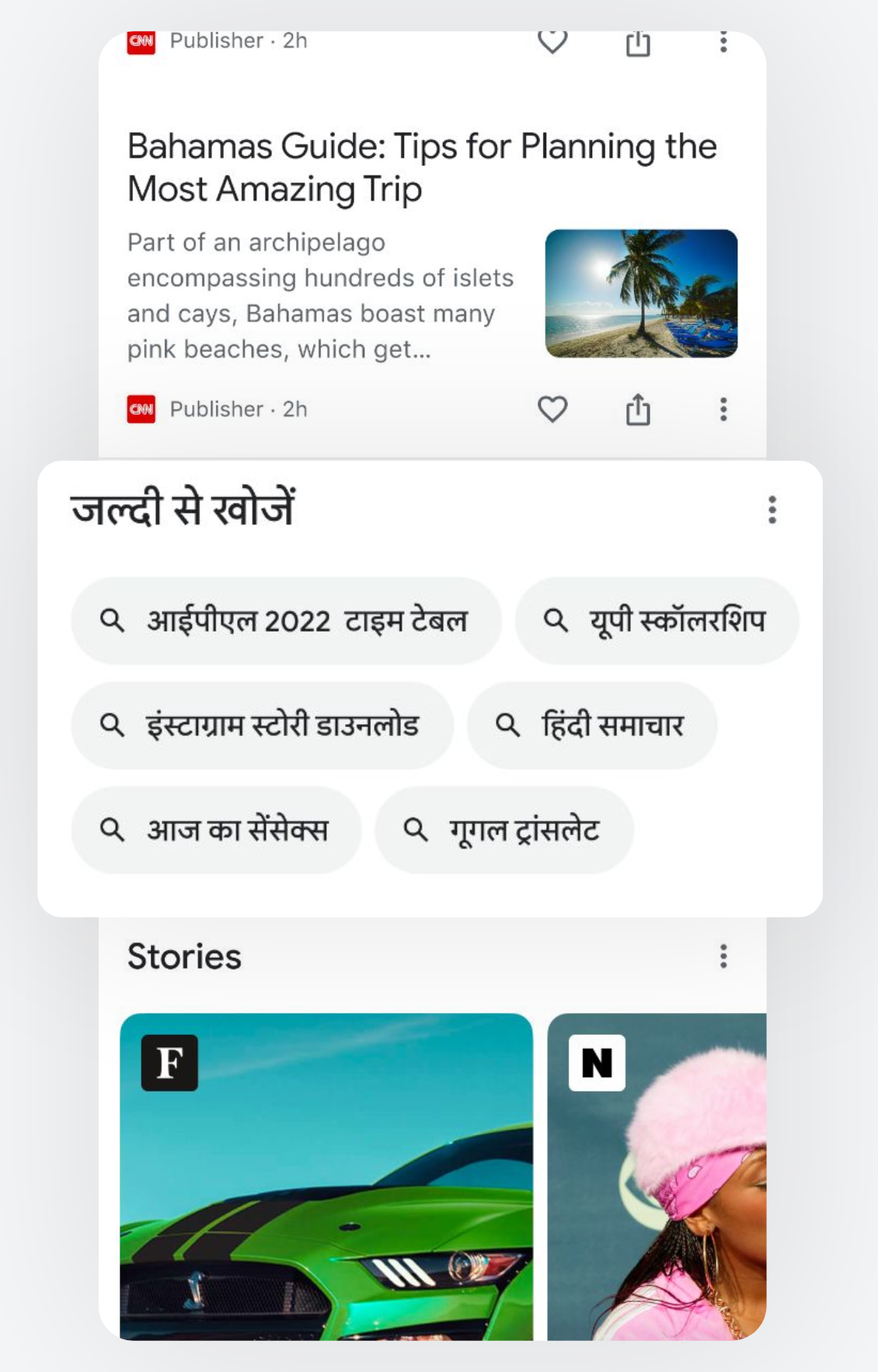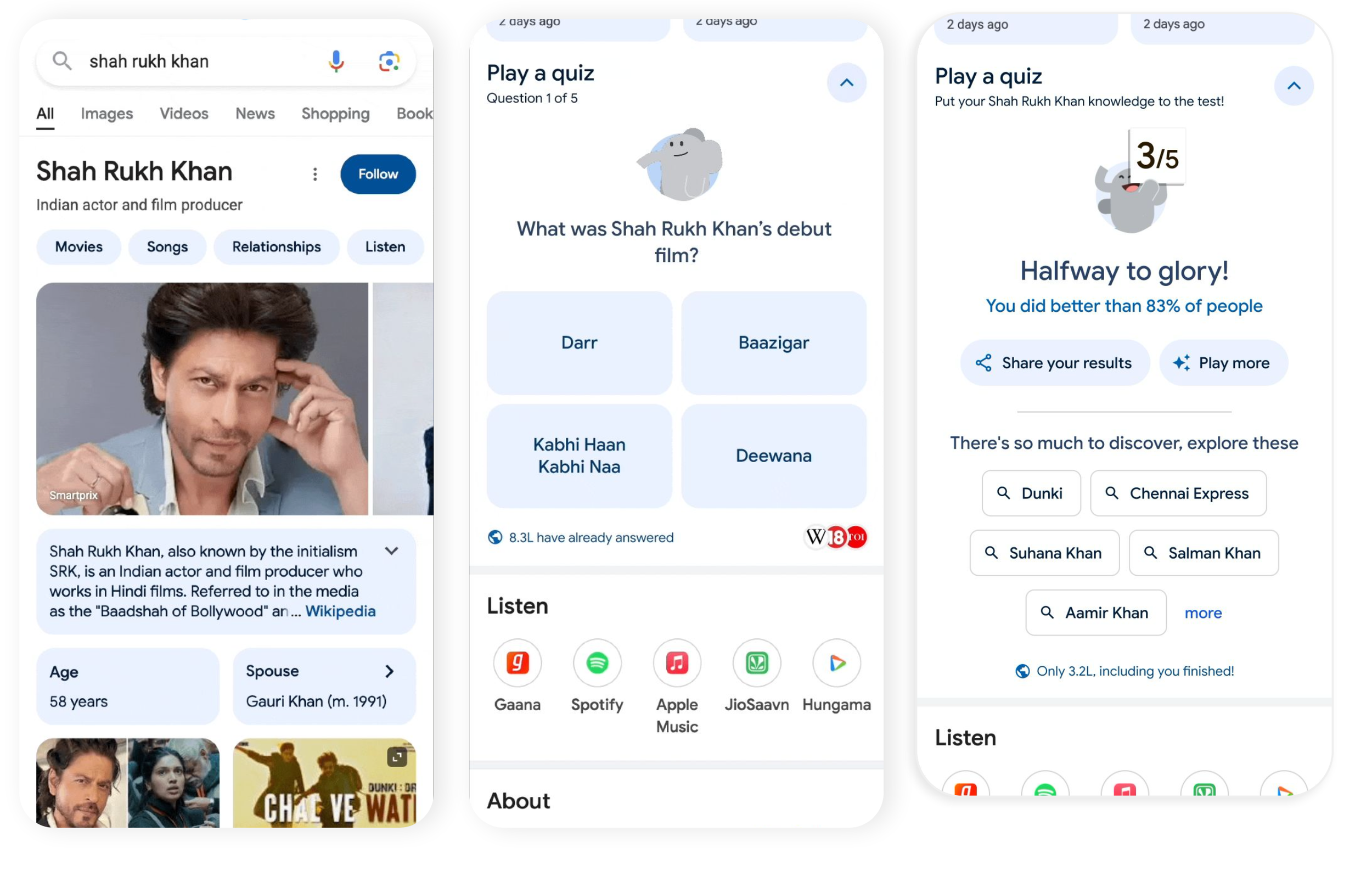Google International & Growth (2022–2024)
Shaping Search into a truly global-first product, ensuring sustained growth in key markets
My Role: UX Director for International & Growth
Search International & Growth are a purpose-driven team who are passionate about evolving our collective understanding of global users needs and the engagement gaps in order to build products to close them faster. We aspire to shape Search into a truly global-first product, ensuring sustained growth and business impact in the long term. For three years now, I’ve led the UX organization for international & growth.
Our local teams are based in India, Japan, Sub-Saharan Africa and Brazil.
As far as where we focus, we have three priorities. First, we drive growth for Search in these markets and we do this by having a cross-functional team that is based locally, immersed in these countries, proximate to our users, and close collaborators with our partners.
Second, through research, insights and design, we look to use these markets to uncover blindspots in our product and new opportunities for innovation that otherwise would not be on the radar for Search.
And third, we’re here for all of Search to support global teams in better understanding and building for different parts of the world. Which leads to the question, what do you need to know about designing for different parts of the world? That’s precisely what we’re going to touch on today for these key strategic markets for Search.
We’re seeing the center of gravity of the internet is shifting away from Western markets and what worked well for the first wave of internet users is not always relevant among newer waves of internet users, particularly those in different contexts and cultures in which the internet was developed. This gap is being filled by local product offerings that take into account the unique needs and constraints of these users.
While Google is undoubtedly relevant and loved by these users, the role Google plays in their broader internet use is more limited due to a mismatch of product design expectations, lack of relevant local content, and variation in the role of the internet in everyday life. In order to continue to have relevance with new cohorts of users, we need to evolve our understanding of what success looks like and move toward understanding our place in the broader ecosystem of product offerings.
Our program has the unique charter of evolving and adapting our core products in each of our strategic markets to experiment and push the boundaries of how to evolve our products to be more globally relevant and universally helpful for everyone on Earth.
International Markets are a big lever for growth for Search. The growth opportunity intrinsic to these markets is disproportionately large. It is impossible to attain Search’s longer term objectives without international success, and particularly success in India.
These markets provide a dual opportunity for experimentation:
First they give us scope to experiment with product innovation in the specific segments and dynamics above
Second they provide (in markets other than India) a materially lower risk environment to experiment more widely and boldly than in our core Western markets. This is currently underleveraged but is starting to be recognised.
Thirdly, they provide an opportunity for cross-organizational collaboration that is challenging and hard to prioritise in our core markets. This is driven in part by the higher opportunity, in part by the lower risk, and in part by the greater country-first orientation in these markets.
Much of our work remains confidential as a part of Google Search’s active strategy. However, I’ll share a few snapshots of work from some of our key markets—much of it driven by the UX team.
Search in India
Our team is on a mission to transform the daily lives of a billion Indians. Anyone with internet access—that's our target. To meet their information needs, we strive to make things easier, effortless and convenient.
We want to be more than just helpful. We want to bring delight, a little joy and surprise to our users' everyday tasks.
There are a few key considerations we keep in mind as we build products for our users in India. While these have disproportionate impact here, we know that they often scale, especially to multiple emerging markets.
In a multi-lingual country like India where less than 1% speak English fluently, we can’t think about Language use and fluency as binary - especially when we consider modalities like speaking, reading, writing, and typing.
Our users’ world is filled with sound, vibrant colors, and competing products that jostle side by side to stand out. When we use white as the primary defining space within products it can feel unfamiliar giving the impression that our products are not built for them.
Many users in India, avoid exploring and trying new things because they fear breaking something. So, Onboarding and upboarding users by building the awareness of value, hand-holding them, building “Forgiving journeys” along with positive reinforcement to try new things is important for adoption.
For example, this feature launch provided users with tappable queries to start their search journeys, thereby reducing the friction of query formulation in the Hindi language.
As one user told us,
“This is just one click to get my work done. Let’s say I want to find a shayari (devotional), I will click on this instead of having to search for it by typing.”
Like other modern products, our team in India is also on a mission to make Search a true companion to users in India throughout their information journeys using Generative AI.
Our team was responsible for launching the largest expansion yet for AI Overviews in Search with a launch in more than 100 countries, making the product accessible in more languages—helping vast populations of people search in a whole new way, no matter what questions are on their minds. With this expansion, AI Overviews now have more than 1 billion global users every month.
Our team also added multimodality to AI Overviews for the first time ever. In key markets like India, users can now toggle between English and local languages. They can also have the text read to them over audio and they can respond with voice input. All of these are critical interactions for populations around the world that may be more averse to typing and reading on their phones.
What’s more, generative AI and large language models can revolutionize user experiences beyond traditional question and answer formats. By taking an India-first approach to finding opportunities for these technologies to address real users’ needs, we’ve been able to land exciting features that a team, say based in the US, would otherwise not have conceived.
For example, games, especially knowledge or info games are integral to Indian culture. It’s common to see families and friends asking each other riddles, trivia, and general knowledge questions as a way to bond, have fun and pass time together. We had an intuition that this could be a good direction for us to explore.
Our hypothesis was that users are motivated to challenge themselves and test their knowledge in their topic of interest. Along the way, we will be able to inspire them to seek more information to fill their knowledge gaps.
When a user searches for an entity on Search—a person, place or thing—we designed an experience for LLM-generated trivia-based quizzes. They are a fun and lightweight test of knowledge while also inspiring new info needs and exploratory questions.
In live experimentation, the results support our hypothesis. Users are indeed interested in testing their knowledge about a topic, with an exceptionally high click through rate in India. Additionally, over 70% users who have played the quiz query more and repeat their plays as well.
With that validation we are already exploring more content types and game formats, that not just engage users but also pique their curiosity and inspire new journeys.
Search in Japan
In Japan, the market is vastly smaller than India, but users are online to an extraordinary degree and much more engaged from a commercial standpoint. Several cultural insights have been profound in influencing our product strategy.
The first, Omotenashi. The concept of omotenashi means thoughtfully anticipating one’s needs from the host’s heart, unstaged, with no hidden agenda. Therefore, the expectations for quality service are extremely high. Japan is a high context society, meaning that Japanese people are accustomed to communicating without expressing the detailed nuances in words. And these unspoken nuances are actually what they value the most.
Second, Curated options are a norm. In Japan, well-curated information is available everywhere, in stores, restaurants, magazines etc. Therefore, users naturally seek curated content online too. They seek curation and guidance.
Third, the reality of a fear of failure in a community-oriented culture. Japanese culture is oriented towards communal expectations and conformity, making standing out and making mistakes risky. As a result Japanese people spend a lot of time ensuring their public personas are aligned with society's expectations. For this reason it is very important to be well-prepared and have all the information upfront.
Which brings us to the fourth cultural insight. People in Japan want to be well-prepared to avoid regrets later. This might manifest itself as trend seeking.
Japanese users have a different primary motivation to use the internet than we see in Western contexts. For example, in the US, people state that the primary purpose of the internet in their lives is for looking for information to answer their questions. Whereas Japanese people want to be more connected to their interests and passions.
This translates as a vast umbrella of local user needs and preferences, ranging from wanting to be in the know of trends to expecting step by step guidance and curation.
We initially focused our efforts on helping users be in the know of the current social sentiment and trends around interests—a critical need for a collectivist society.
In late 2022, we launched “Hashtag search”, a product that allows users to get a birds-eye view of all that’s happening across social platforms and the open web. We had a hypothesis that we would see higher engagement with a product that would over-index on freshness and “zeitgeisty” content.
We were right. Not long after launch, despite no marketing, we saw daily users increase substantially in Japan and searching via hashtags rather than traditional queries increased over 1000%. Time on the Search Results Page was also boosted by over 10%
At the same time, we also knew there’s a lot more we could do, especially to meet our users needs around curation and depth. We started working on a broader product vision that explores new surfaces:
The first is a “hub” aggregating all your interests to stay in the know that build upon common Japanese patterns such as trend ranking, real life events and really niche topics.
The second is a consumption experience experiment that allow users to go really deep on niche/curated content, leveraging a partnership with a team specializing in LLMs, that aims to curate sets of content in the manner of an ‘omakase’ menu.
Our team believes consumption preferences of users across Asia are not being fully met yet and there are opportunities in continuing to explore new paradigms.
In conclusion,
Our team is lucky to have been given the charter to weave together user insights and innovative ideas to drive product strategies across the globe that solve real world user needs and lead the business into new areas of opportunity. We’ve built expertise across key markets including India, Japan, Sub-Saharan Africa, and Brazil making the team uniquely suited to understand, advocate and solve for the needs of users on a truly global level. With a strong focus on users and culture, we’ve found ways to work across organizational boundaries, rally people around ideas and solutions that matter for people across the world.
